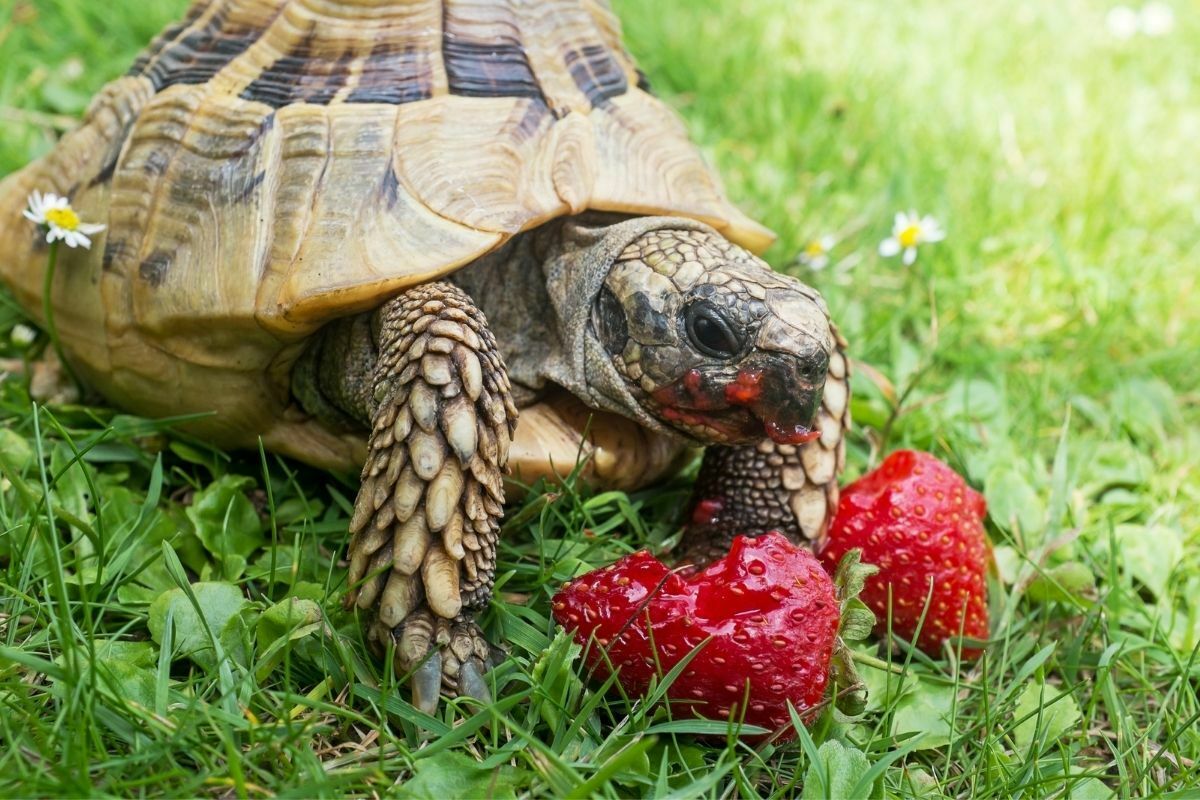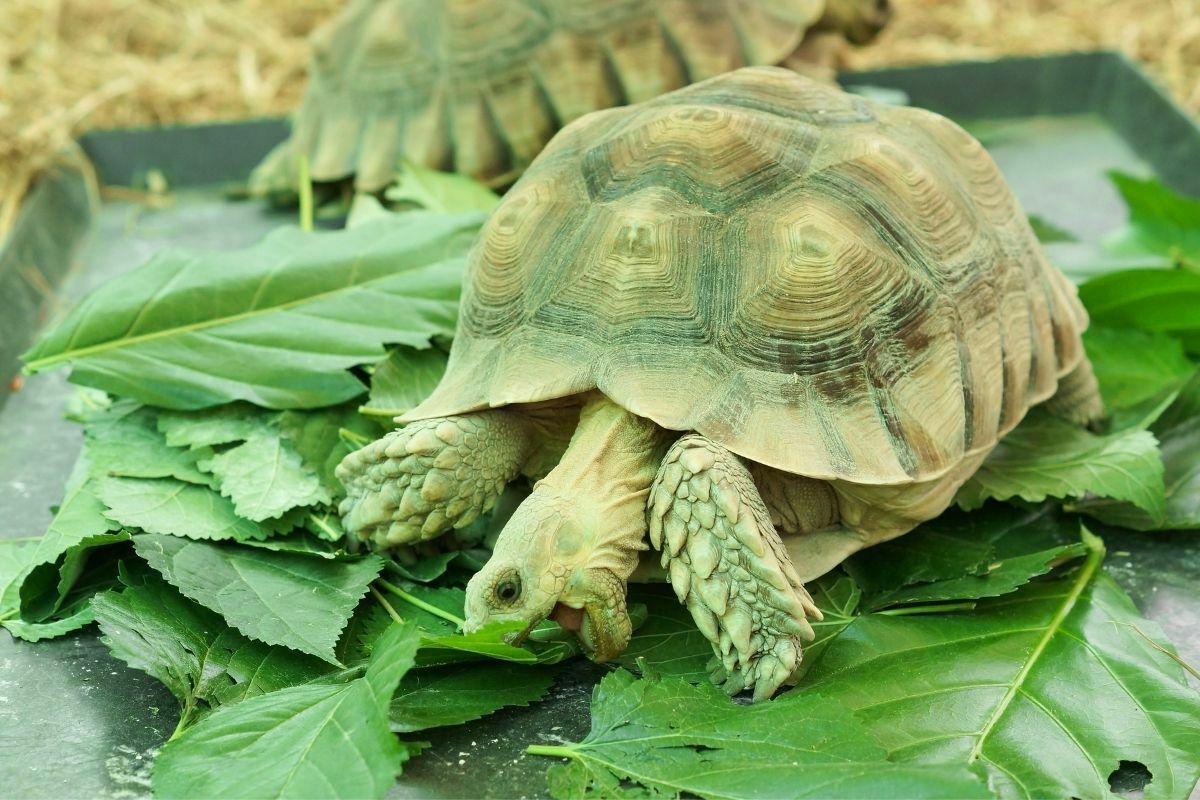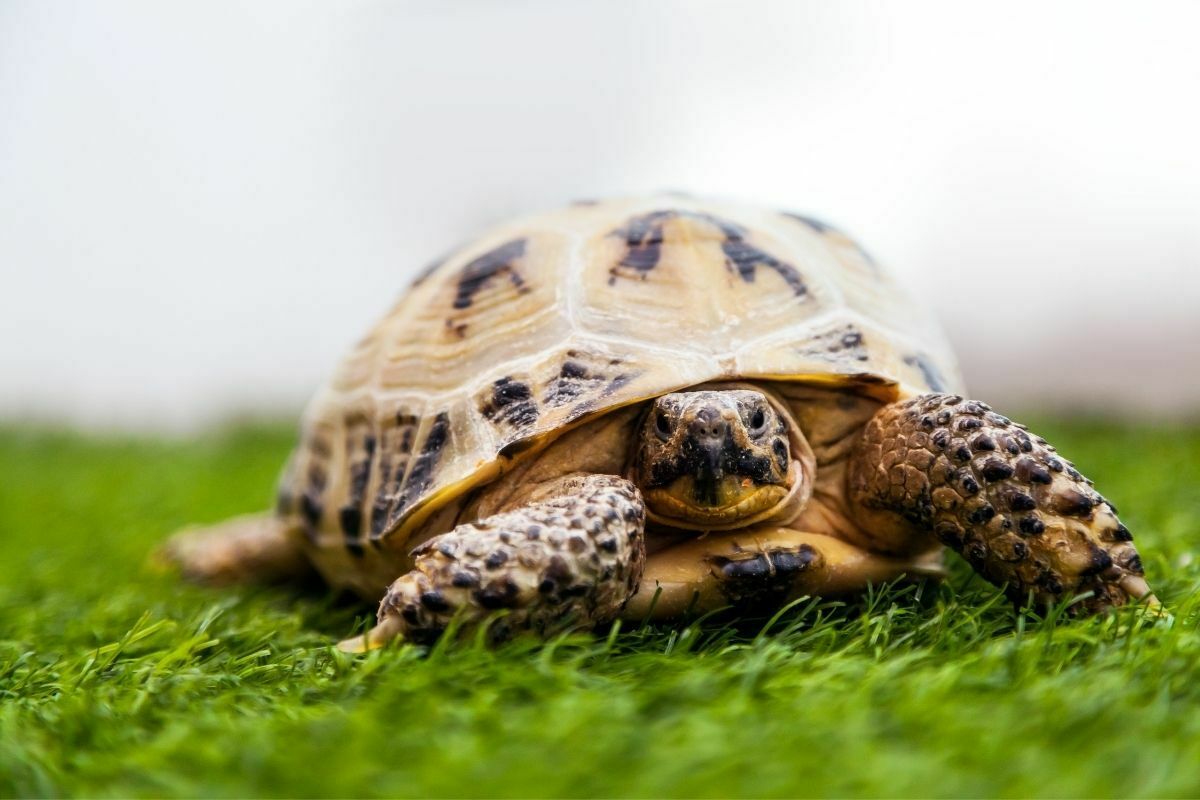Tortoises are reptiles, and they are also called turtles or terrapins. There are two main types of tortoises: land tortoises and sea tortoises.
Land tortoises live in dry areas such as deserts, grasslands, and savannas. Sea tortoises live in tropical regions.

A tortoise is a slow-moving animal. Its body temperature is usually between 95 °F (35 °C) and 105 °F (40 °C).
Their average life span is 50 years, and comes in many colors and patterns. In this article, we will discuss how you should feed a tortoise and its nutritional needs.
What Do Tortoises Eat In The Wild?
Tortoises eat insects, worms, snails, small mammals, fruits, vegetables, and other plants. Some species have been known to eat carrion and even dead animals. Yet typically, they will be seen eating a very plant-based diet of various leaves.
Tortoises can be found all over the world. They are native to Africa, Europe, Asia, Australia, North America, South America, Central America, and Mexico.
In nature, tortoises do not hibernate like bears and squirrels. Instead, they go into a state of torpor. This means that they stop eating and digesting food for up to 6 months at a time. During this period, they use stored fat and body heat to keep warm.
When it’s time to get active again, they wake up from their torpor and start eating and digesting food again.
The diet of a tortoise depends on its habitat. For example, desert tortoises eat mostly cactus and succulents. These plants provide them with water and nutrients. On the other hand, African-spurred tortoises eat more fruit than cacti.
Mediterranean tortoises make up the majority of the tortoise population. At the same time, tropical tortoises have been known to eat in small quantities insects, worms, and slugs.
Location Matters!
As we have mentioned above, there are various different types of tortoises, and where they are based will affect their diet.
Desert tortoises are known to have a similar diet to Mediterranean tortoises. Sometimes the diet of the tortoise can also be influenced by the age of the animal as well.
You should always check what species your tortoise is before you try to give them any food. Tortoises that are in captivity, they are commonly omnivorous; tropical tortoises will happily live off a diet based on plants.
However, be careful. If you try to feed a vegetarian tortoise any kind of insect or meat, this could make them seriously ill. There it should always be followed; that’s why it is important to do your research.
As you can see, there are a lot of species of tortoises, so it can be confusing knowing what to feed them. It is critical to remember that the majority of tortoises, no matter the species, will live a happy life with a diet based on flowers, greens, and vegetables.
You should always be cautious with what you feed your tortoise, and if you are in doubt, then go for a herbivore diet.
They do enjoy a plant-based diet, and if they are captive tortoises, then they will know that they have a stable and frequent food source. Therefore, they won’t have to resort to insects or slugs, which could make them ill.
What Can You Feed A Pet Tortoise?

No matter the species of tortoise, they are known to eat a large range of plants. Yet, for tortoises that are in captivity, their needs can vary dramatically.
We have chosen a few well-known and popular tortoise species that are commonly seen in capacity. We will discuss their diet needs to give you an insight and see how their diets can differ.
Sulcata
These tortoises are native to South America. They are often found in captivity due to their size and ability to survive in a variety of habitats.
They are known to eat mainly fruits, but they can also eat leaves and roots. Commonly they will be seen munching on grass, hay, and weeds.
Alongside this, they enjoy eating dandelions but will also like eating the prickly pear cactus. Yet sometimes, they require calcium powder sprinkled over their food for some extra nutrients. They are very adaptable and will thrive in a wide range of conditions.
Cuvier’s
This is one of the most common species of tortoise in captivity. They are usually kept in groups of 2-3 individuals and are native to Africa and Asia. They are known to be able to live in a wide range of environments.
Yet, they love to eat grasses and herbs, but they will also eat leafy green vegetables and fruits. They require a high level of humidity, which makes them perfect for keeping indoors.
Galápagos
These are the famous tortoises from the Galápagos Islands. They are native to Central and South America. They are known to prefer to live on land than on the water.
Generally, they are also known to like to eat fruit, but they will also take advantage of other foods such as seeds and nuts.
Typically, their diet will consist of around 2/3 to 3/4 of hay or grass and the rest will be greens, flowers, or weeds. They are quite easy to keep and will get along well with others of their species.
Leopard and Aldabra tortoises also have a very similar diet to the Galápagos tortoise, too.
Russian Tortoise
These are native to Eastern Europe, Russia, and Siberia. They are known to live in a wide variety of habitats. They can be found in captivity because of their size and ability to withstand harsh weather conditions.
Furthermore, they are known to love eating fruits and vegetables, but they will also enjoy eating worms and insects.
As a result, they have much less grass in their diet compared to other species of tortoise we have spoken about. Instead, greens and vegetables make up more of their diet. They tend to be more active at nighttime and will sleep during the day.
Nutrition Requirements For Tortoises
As you may have noticed, all tortoises are herbivores. This means that they only eat plant material. It should come as no surprise then that they require a lot of protein. In fact, it has been proven that they don’t need as much protein as humans do.
The best way to feed your tortoise is by giving them a mix of both. You can give them a blend of meat and vegetables, or you can give them a combination of whole grains and veggies.
If you choose to go with the latter option, you might want to consider feeding them a bit of fish as well. Fish is an excellent source of protein and vitamins.
It does surprise a lot of people that tortoises are omnivorous animals. If you want to give them meat, you can either feed them raw or cooked.
Raw meats provide a lot of nutrients without adding extra fat to the tortoise’s diet. Cooked meats are good because they add flavor and texture.
When you are deciding between meat and veggies, you should think about which one provides the most nutrition for your tortoise. You should try to balance out your tortoise’s meal so that it gets a good mix of both.
However, as mentioned above, tortoises don’t need a lot of protein, as this could affect their liver and kidneys if they consume too much.
Although, you must always check the diet of the species of tortoise you are trying to feed. They all have different diets, and you need to follow their diet to keep them healthy.
Additional Tortoise Food Ideas
You should try to stick to feeding your tortoise a healthy and balanced diet. Yet giving your tortoise a variety in their diet is nice as well, so that they don’t get bored by eating the same things every day.
As humans, no one wants to eat the same salad every day, and tortoises don’t want to eat the same meal every day, either.
Therefore, try to give your tortoise a bit of variety in their diet. This could be added when you can get your hands on some artichoke and blackberry/raspberry/strawberry leaves, parsley, aloe, or oregano.
We have specified the leaves for certain plants; this is not to say they can’t eat berries. However, they should really stick to the leaves of the plants. Although, you could always give them a couple of berries now and then as a treat.
Commercial Tortoise Food
If you are struggling to know what to feed your tortoise, there are many pre-made foods out there for tortoises. Although, this pre-made food doesn’t have a lot of nutritional benefits for your tortoises.
Zoo branded tortoises food, and Maurier tortoise foods are the two main decent commercial tortoise foods that you can buy. They both help to add a bit of variety to your tortoise diet. However, you couldn’t use this pre-made food as a meal forever.
If you are to buy commercial tortoise food, you must always check the labels and know what is in the food.
A tortoise is known to eat over 200 plants in the wild. This is why it is important to vary your tortoise’s diet, to keep them healthy and happy, and to help them enjoy their meal times.
However, you should only be giving them food that you know they can have. This is why you must check the ingredients in pre-made tortoise food.
Which Foods Are Not Safe For Your Tortoise?

Tortoises may look like hard and strong creatures due to their hard shell. Yet their insides are actually quite sensitive; that’s why you must be careful with what you are feeding them. Thus, a tortoise must be given a balanced diet that has plenty of vegetation.
However, there are some things you shouldn’t feed your tortoise. Beans and peas are a type of food you want to stay away from, as they can contain far too much protein for a tortoise to consume.
Alongside this, there are some plants, which are quite commonly found in some gardens, that could be poisonous to a tortoise. The following are plants that you should never feed your tortoise:
- Avocado seeds and leaves
- Boxwood
- Ivy
- Ficus
- Asparagus fern
- Buttercups
- Daffodil
- Primrose
- Iris
- Holly
- Begonia
- Juniper
- Calla Lily
- Nightshade family
- Castor bean
- Poinsettia
- Amaryllis
- Crowfoot
- Ficus
This isn’t the whole list. Yet, if you are in doubt, keep your tortoise away from it and go and ask a professional. It is better to stay on the side of caution than let your tortoise eat something that they shouldn’t.
Also, not every species of tortoise enjoys a grass-heavy diet; some tortoise stomachs cannot handle the high quantities of silica which is found in the majority of hay and grasses. This is something to be aware of, depending on the species of your tortoise.
Why Do You Need To Add Calcium To A Tortoise Diet?
A lot of people will tell you that you need to add calcium to your tortoise diet, and this is a really important thing. Adding calcium to your tourist diet is extremely important, as it helps them to continue growing and to keep them healthy as well.
The added calcium keeps their bodies healthy and strong. While also, calcium helps their bodies to digest the food that they are eating.
An essential thing to be aware of is the calcium you give to your tortoise shouldn’t have a high percentage of phosphorus. This is because a high percentage of phosphorus will actually stop and block the absorption of the calcium you want your tortoise to absorb.
Young and female tortoises need much more calcium than male tortoises. As well as, pregnant tortoises require even more calcium than normal, as they require the extra calcium not only for themselves but for their eggs to help them to develop and be healthy.
The best way to add calcium to their diet is through calcium powder. However, there are chewable options as well.
Be careful what calcium powder you are giving to your tortoise, as not all human calcium powders are safe for tortoise consumption. In short, get a phosphorus-free powder that also contains vitamin D.
How Often Should You Feed Your Tortoise?
There is no set rule when it comes to how often you should give your tortoise food. Some people say once or twice a day; others say three times a week, depending on their age.
However, it is very important to note that feeding your tortoise regularly does not mean that you need to overfeed them.
If you give them enough food, they will be able to maintain themselves and grow properly. Thus, the size of the meal is just as critical.
However, it is good to remember that tortoises do not like to overeat, so make sure that you don’t overfeed them. They may become overweight and unhealthy.
Some owners like to give their tortoises several small meals every few days. This gives them a chance to eat and graze when they feel like it.
Frequently Asked Questions
What Must Be In A Tortoise Diet?
All tortoises require access to fresh, clean water. They also need protein to grow and develop properly. A pelleted diet is important for growing reptiles.
Energy should be added to the diet of grass-eating tortoises. Vitamin E, A, and calcium supplements are recommended to help maintain the health of these tortoises.
Tortoises require high-quality grass hay, raw vegetables, and pellets made out of high-quality ingredients.
How Long Can I Keep My Tortoise?
You can keep your tortoise for up to 10 years if you provide them with proper care. It depends on the species of tortoise.
What Do Tortoises Drink?
Like the majority of animals, tortoises will drink water. This water should be clean and fresh.
Conclusion
Now you know everything about how to feed a tortoise and how to look after them. Hopefully, this guide has helped you out with some information about caring for your tortoise.
Remember to always check with a professional before adding any new foods to your tortoise’s diet.
